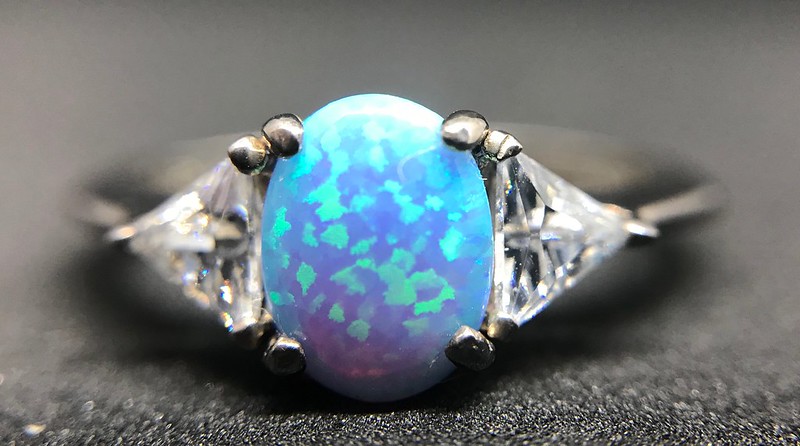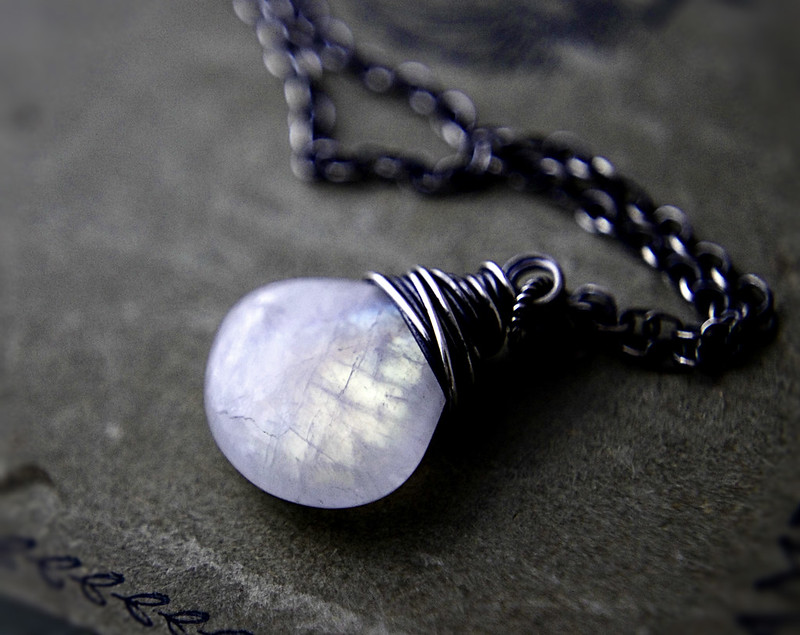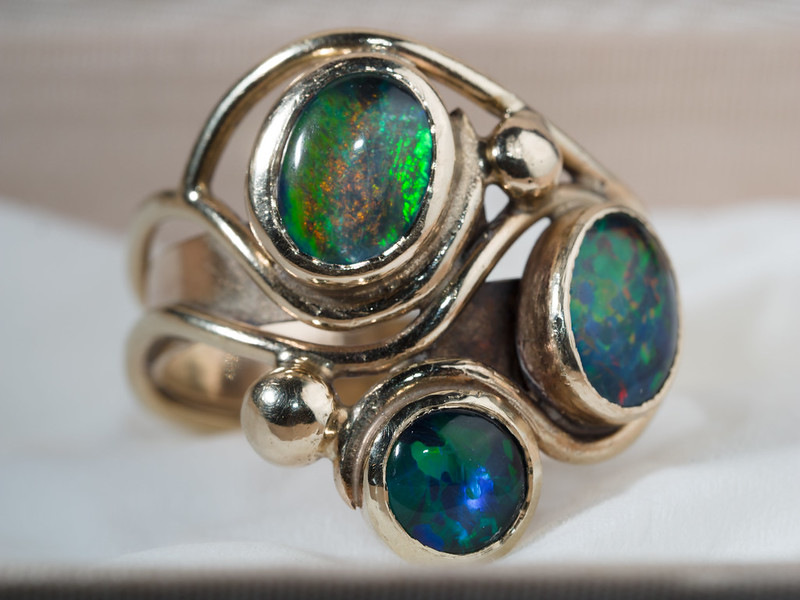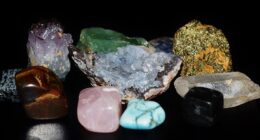Opals are more fragile but can display a wider range of colors than moonstones. Moonstones, on the other hand, come with a beautiful play of light that gives them an ethereal quality. If you prefer durability and versatility in color options, opal is your best bet. But if you want something with a mystical aura and subtle shimmering effect, then moonstone might be perfect for you.
What is opal?
(Photo by Stephanie Borkowski on flickr)

Opal is a stunning gemstone that has captivated people for centuries. It’s known for its iridescent play of color, which shimmers and changes as the stone moves. This effect is caused by microscopic silica spheres that diffract light like a prism.
Opals are formed from silicon dioxide gel deposited in rock crevices or voids over millions of years. The most valuable opals come from Australia, but they can also be found in other parts of the world including Mexico, Brazil, and Ethiopia.
The colors of opals range from clear to white, gray, black or even bright orange-red hues. They may have either a transparent or opaque body with flashes of blue-green or red-orange when viewed at different angles under light sources such as sunlight.
Opals have long been associated with magic and mystery due to their unique appearance. They were once believed to possess healing powers and were worn by ancient civilizations for good luck and protection against evil spirits. Today they are still highly sought after for their beauty and rarity in jewelry-making around the world.
What is moonstone?

Moonstone is a unique gemstone that has been prized for its beauty and mystical qualities throughout history. It is a type of feldspar mineral that can be found in different parts of the world, including Sri Lanka, India, Australia, and the United States.
What sets moonstone apart from other gemstones is its iridescence or adularescence. This effect gives it an almost shimmering appearance with flashes of blue light moving across the surface when you move it around under light.
This stone comes in different colors such as white, grey, peachy cream or sometimes even pinkish shades. But what makes this stone very special are its spiritual properties which includes bringing good fortune to those who wear it as well as enhancing intuition and creativity.
Moonstone has been used by many cultures over time not just because of its physical beauty but also because of how it connects to one’s mind and spirit through meditation practices.
Opal Vs. Moonstone – Key differences
Opal and moonstone, both popular choices for gemstones, have distinct characteristics that set them apart. While they may appear similar at first glance, a closer look reveals key differences between these captivating stones.
Opals are known for their stunning play of color. This phenomenon is caused by the diffraction of light within the stone, resulting in a mesmerizing display of hues ranging from blues and greens to reds and oranges. Opals can be found in various types such as white opal, black opal, boulder opal, and fire opal – each with unique properties.
Moonstones, on the other hand, exhibit an enchanting adularescence. This optical effect creates a soft sheen or glow that seems to move across the surface when rotated under light. The name ‘moonstone’ derives from this mysterious lunar-like appearance.
In terms of composition, opals are formed from hydrated silica while moonstones belong to the feldspar mineral family. These different chemical makeups contribute to their varying visual effects and physical properties like hardness (opal: 5-6 Mohs; moonstone: 6-6.5 Mohs).
Another distinction lies in their cultural significance throughout history. Opals were revered by ancient Romans who believed they held powers of good luck whilst moonstones were associated with love and fertility by many civilizations including Rome and India.
What is better opal or moonstone?
Opal and moonstone are both beautiful gemstones, but they have their own unique characteristics and qualities.
Opal is a gemstone that is known for its iridescent play of color, which is caused by the diffraction of light through tiny silica spheres in the stone. Opals can come in a range of colors, including white, black, and boulder opals, and are often prized for their unique and dazzling appearance. However, opals are also relatively soft and delicate, and require careful handling and maintenance to avoid damage.
Moonstone, on the other hand, is a type of feldspar mineral that is known for its attractive shimmering effect, known as adularescence. Moonstone is typically found in shades of white, grey, or blue, and is often used in jewelry. It is also a relatively durable stone, which makes it a popular choice for everyday wear.
Ultimately, the choice between opal and moonstone depends on personal preference, as well as the intended use of the stone. If you are looking for a unique and eye-catching gemstone for special occasions, then opal may be the better choice. If you are looking for a more durable and versatile gemstone for everyday wear, then moonstone may be the better option.
How do I identify an opal?
Identifying an opal can be quite tricky as it comes in a variety of colors and patterns. However, there are some key characteristics that can help you identify an opal.
Firstly, look for the play of color – this is when the stone appears to change color when viewed from different angles or under different lighting conditions. Opals with stronger and more vibrant play of color are generally considered to be higher quality.
Secondly, check the hardness of the stone. Opals are relatively soft compared to other gemstones, so they can be easily scratched or damaged if not handled carefully.
Thirdly, examine the surface texture and patterns on the stone. Opals may have natural markings called ‘patterns’, which often resemble fingerprints or swirls within the body of the stone.
Consider where and how you obtained your opal – reputable jewelers will usually provide certificates of authenticity that confirm whether your opal is genuine or synthetic.
By keeping these factors in mind when identifying an opal, you’ll be able to distinguish between genuine stones and imitations with greater ease!
How do I identify an moonstone?
Identifying a moonstone requires a keen eye and attention to detail. Firstly, you should look at the stone’s color, which can range from transparent to opaque with hues of blue, green, or white. Moonstones have an iridescent quality known as adularescence that is caused by light scattering within its structure.
To identify a genuine moonstone, check for any visible inclusions or cracks on the surface as natural moonstones often contain these imperfections. Synthetic stones may appear perfect without any blemishes.
Another way to tell if it’s real is through testing its hardness – genuine moonstones rank 6 on Mohs scale of hardness whereas imitations are softer and easily scratched.
You could also perform a water test by placing the stone into a glass of water. If it sinks, it might not be real since most authentic moonstones have a lower density than water and will float instead.
By following these tips while examining your gemstone carefully under good lighting conditions either individually or together with other gems like opals or pearls can help you confirm whether your rock is indeed genuine!
Does moonstone glow in the dark?
One of the most interesting and alluring characteristics of moonstone is its ability to display an ethereal glow that seems to emanate from within. But does it really glow in the dark like some other gemstones?
The answer is no, moonstone does not actually glow in the dark. The phenomenon known as adularescence – which gives moonstone its signature shimmering effect – is caused by light interacting with microscopic layers of feldspar minerals within the stone. When light enters these layers, it scatters and reflects off them, creating a unique play of color and light.
While this effect can be quite striking under certain lighting conditions, it doesn’t give off any actual luminescence in darkness. That being said, there are certain types of stones that do possess phosphorescent properties and will continue to emit a faint glow after being exposed to UV or blacklight sources.
Featured Image By – James Petts on flickr








